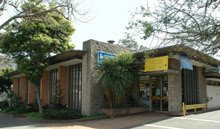 California Hall, San Francisco. January 1, 1965.
California Hall, San Francisco. January 1, 1965.46 years ago an event occurred which served to coalesce the emerging LGBT community in San Francisco. Police harrassment of homosexual men and women was witnessed first-hand by straight men and women. They were appalled and were very public about their outrage.
In the mid-1960s members of the gay community and the religious community sought to find common ground. The Council on Religion and the Homosexual sponsored a fundraiser, a Mardi Gras Ball. Attendees included homosexual men and women along with local clergy and their wives.

Evander Smith was a San Francisco lawyer who along with Herbert Donaldson was retained by the Council on Religion and the Homosexual. Anticipating police harassment at the ball, Smith and Donaldson were asked to attend the event in case legal advice was necessary.
In fact the police did take photographs of attendees arriving and requested admission to the event on two occasions. The first was to examine whether the event was in accord with rules regarding liquor; this was standard practice and the police were admitted to ascertain that the event was in compliance. At a later time, the police asked for admittance again and were denied because they did not have tickets for the private event and could provide no reason to enter. As a result, four people were arrested: Evander Smith, Herbert Donaldson, Elliott Leighton and Nancy May.
 The Hormel Center contains the Evander Smith -California Hall Papers. The collection includes case files on the legal defense of Smith, Donaldson, Leighton and May. The files contain a chronology of the events that took place, legal research on the laws pertaining to those events, notes on jury selection, materials concerning homosexuals and their treatment by authorities, clippings of newspaper coverage and cartoons, a few photographs of attendees and police, and some homosexual publications of the time. There are also copies of sermons or papers enclosed in Methodist Church service programs of January 1965.
The Hormel Center contains the Evander Smith -California Hall Papers. The collection includes case files on the legal defense of Smith, Donaldson, Leighton and May. The files contain a chronology of the events that took place, legal research on the laws pertaining to those events, notes on jury selection, materials concerning homosexuals and their treatment by authorities, clippings of newspaper coverage and cartoons, a few photographs of attendees and police, and some homosexual publications of the time. There are also copies of sermons or papers enclosed in Methodist Church service programs of January 1965. Nan Alamilla Boyd's book Wide Open Town:a history of queer San Francisco to 1965 is an excellent history of the events leading up to and through this moment in San Francisco LGBT history. The Evander Smith/California Hall Papers are available through the San Francisco History Center, 6th Floor, Main Library.



